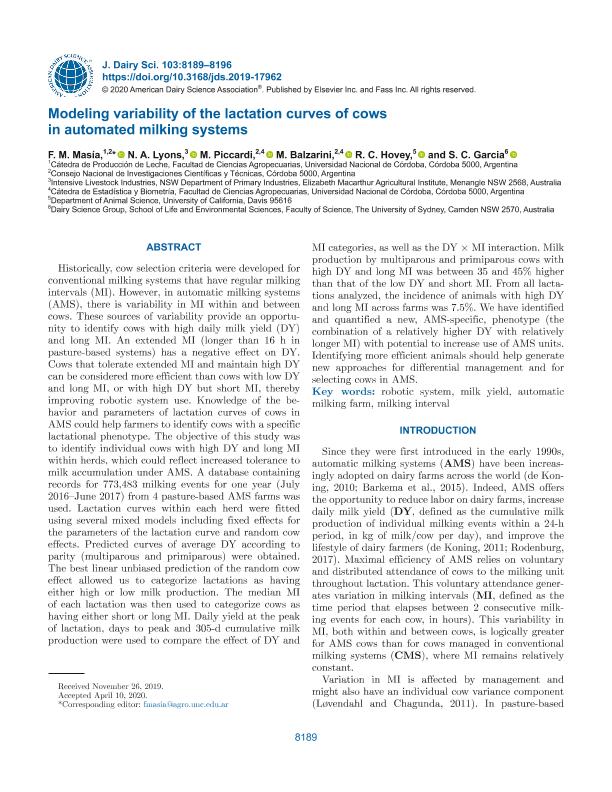Mostrar el registro sencillo del ítem
dc.contributor.author
Masía, Fernando

dc.contributor.author
Lyons, N. A.
dc.contributor.author
Piccardi, Mónica Belén

dc.contributor.author
Balzarini, Monica Graciela

dc.contributor.author
Hovey, R. C.
dc.contributor.author
Garcia, S. C.
dc.date.available
2021-10-12T18:12:18Z
dc.date.issued
2020-09
dc.identifier.citation
Masía, Fernando; Lyons, N. A.; Piccardi, Mónica Belén; Balzarini, Monica Graciela; Hovey, R. C.; et al.; Modeling variability of the lactation curves of cows in automated milking systems; American Dairy Science Association; Journal of Dairy Science; 103; 9; 9-2020; 8189-8196
dc.identifier.issn
0022-0302
dc.identifier.uri
http://hdl.handle.net/11336/143309
dc.description.abstract
Historically, cow selection criteria were developed for conventional milking systems that have regular milking intervals (MI). However, in automatic milking systems (AMS), there is variability in MI within and between cows. These sources of variability provide an opportunity to identify cows with high daily milk yield (DY) and long MI. An extended MI (longer than 16 h in pasture-based systems) has a negative effect on DY. Cows that tolerate extended MI and maintain high DY can be considered more efficient than cows with low DY and long MI, or with high DY but short MI, thereby improving robotic system use. Knowledge of the behavior and parameters of lactation curves of cows in AMS could help farmers to identify cows with a specific lactational phenotype. The objective of this study was to identify individual cows with high DY and long MI within herds, which could reflect increased tolerance to milk accumulation under AMS. A database containing records for 773,483 milking events for one year (July 2016–June 2017) from 4 pasture-based AMS farms was used. Lactation curves within each herd were fitted using several mixed models including fixed effects for the parameters of the lactation curve and random cow effects. Predicted curves of average DY according to parity (multiparous and primiparous) were obtained. The best linear unbiased prediction of the random cow effect allowed us to categorize lactations as having either high or low milk production. The median MI of each lactation was then used to categorize cows as having either short or long MI. Daily yield at the peak of lactation, days to peak and 305-d cumulative milk production were used to compare the effect of DY and MI categories, as well as the DY × MI interaction. Milk production by multiparous and primiparous cows with high DY and long MI was between 35 and 45% higher than that of the low DY and short MI. From all lactations analyzed, the incidence of animals with high DY and long MI across farms was 7.5%. We have identified and quantified a new, AMS-specific, phenotype (the combination of a relatively higher DY with relatively longer MI) with potential to increase use of AMS units. Identifying more efficient animals should help generate new approaches for differential management and for selecting cows in AMS.
dc.format
application/pdf
dc.language.iso
eng
dc.publisher
American Dairy Science Association

dc.rights
info:eu-repo/semantics/openAccess
dc.rights.uri
https://creativecommons.org/licenses/by-nc-sa/2.5/ar/
dc.subject
AUTOMATIC MILKING FARM
dc.subject
MILK YIELD
dc.subject
MILKING INTERVAL
dc.subject
ROBOTIC SYSTEM
dc.subject.classification
Producción Animal y Lechería

dc.subject.classification
Producción Animal y Lechería

dc.subject.classification
CIENCIAS AGRÍCOLAS

dc.title
Modeling variability of the lactation curves of cows in automated milking systems
dc.type
info:eu-repo/semantics/article
dc.type
info:ar-repo/semantics/artículo
dc.type
info:eu-repo/semantics/publishedVersion
dc.date.updated
2021-09-29T14:50:55Z
dc.identifier.eissn
1529-9066
dc.journal.volume
103
dc.journal.number
9
dc.journal.pagination
8189-8196
dc.journal.pais
Estados Unidos

dc.journal.ciudad
Champaign
dc.description.fil
Fil: Masía, Fernando. Universidad Nacional de Córdoba. Facultad de Ciencias Agropecuarias; Argentina. Consejo Nacional de Investigaciones Científicas y Técnicas. Centro Científico Tecnológico Conicet - Córdoba; Argentina
dc.description.fil
Fil: Lyons, N. A.. Intensive Livestock Industries; Australia
dc.description.fil
Fil: Piccardi, Mónica Belén. Universidad Nacional de Córdoba. Facultad de Ciencias Agropecuarias. Departamento de Desarrollo Rural. Área de Estadística y Biometría; Argentina. Consejo Nacional de Investigaciones Científicas y Técnicas. Centro Científico Tecnológico Conicet - Córdoba; Argentina
dc.description.fil
Fil: Balzarini, Monica Graciela. Universidad Nacional de Córdoba. Facultad de Ciencias Agropecuarias. Departamento de Desarrollo Rural. Área de Estadística y Biometría; Argentina. Consejo Nacional de Investigaciones Científicas y Técnicas. Centro Científico Tecnológico Conicet - Córdoba; Argentina
dc.description.fil
Fil: Hovey, R. C.. University of California at Davis; Estados Unidos
dc.description.fil
Fil: Garcia, S. C.. University of Sydney; Australia
dc.journal.title
Journal of Dairy Science

dc.relation.alternativeid
info:eu-repo/semantics/altIdentifier/url/https://www.journalofdairyscience.org/article/S0022-0302(20)30461-6/fulltext
dc.relation.alternativeid
info:eu-repo/semantics/altIdentifier/doi/http://dx.doi.org/10.3168/jds.2019-17962
Archivos asociados
